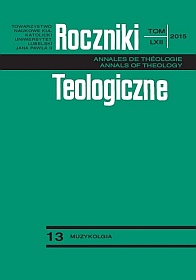The Art of Playing Keyboard Instruments in the Late 17th and Early 18th Centuries. Monsieur de Saint-Lambert and his Les principes du clavecin (1702)
Abstract
This article concerns the execution of the ornaments—a very important question in the stylistic interpretation of the French harpsichord baroque music. The starting-point for reflection is treatise of the Monsieur de Saint-Lambert, a very enigmatic person, the author of Les principes du clavecin, centenant une explication exacte de tout ce qui concerne la tabulature et le clavier avec des remarques necessaires pour l’inteligence de plusieurs difficultées de la musique (The fundamentals of harpsichord playing, with explanations on musical notation and performance, together with explanatory remarks about different music issues), issued in 1702. He was highly valued as a harpsichord teacher and his treatises concerned the different aspects of playing keyboard instruments are the only preserved evidence of his musical and educational activities. It must be noticed that Saint-Lambert was the author of one of the oldest French treatises dedicated solely to the issues of harpsichord playing and his teaching method of mastering the instrument was at that time quite pioneering. The most important part of his treatise is the last nine chapters, focused on practical issues, where we can find the author’s advice on different aspects of existing keyboard music. The main problem in performing harpsichord music at Saint-Lambert’s time was the proper interpretation of music notation, which due to technical constraints (not yet perfect printing and editing of music works), was not able to reflect the whole variety of nuances of contemporary music style. So, the treatise Les principes du clavecin is a very helpful key to the understanding of the 18th century music.
References
Aleksandrowicz, Miłosz. “Praktyka wykonawcza Plain-chant w XVIII wieku. François de La Feillée i jego Méthode nouvelle pour apprendre parfaitement les règles du plainchant (1754).” Annales Lublinenses pro Musica Sacra 3(2012): 33.
d’Anglebert, Jean-Henri. Pièces de clavecin. Paris, 1689.
de Saint-Lambert, Michel. Les principes du clavecin (1702), reprint, Minkoff Reprints, 1972.
de Saint-Lambert, Michel. Nouveau traité de l’accompagnement du clavecin, de l’orgue et des autres instruments (1707), reprint, Minkoff Reprints, 1972.
Fétis, François-Joseph. Biographie universelle des musiciens et bibliographie générale de la musique. Vol. 7. Paris: Firmin-Didot, 1866.
Harris-Warrick, Rebecca (ed.). Principles of the harpsichord. Cambridge: Cambridge University Press, 1984.
Mac Clintock, Carol. Readings in the history of Music in Performance. Bloomington: Indiana University Press, 1979.
Nivers, Guillaume-Gabriel. Livre d’orgue contenant cent pièces de tous les tons de l’Église. Paris, 1665.
Powell, John S. (ed.). A New Treatise on Accompaniment. With the Harpsichord, the Organ, and with Other Instruments by Monsieur de Saint Lambert. Bloomington: Indiana University Press, 1991.
Copyright (c) 2015 Roczniki Teologiczne

This work is licensed under a Creative Commons Attribution-NonCommercial-NoDerivatives 4.0 International License.





